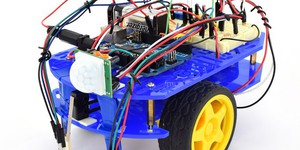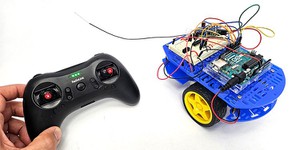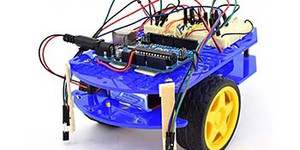Science Projects (19 results)
Browse Science Projects
Over 1,200 free science projects for K-12. Browse by subject, grade level, or try our Topic Selection Wizard to find your winning science project. With science projects in 32 different areas of science from astronomy to zoology, we've got something for everyone!
Let us help you find a science project that fits your interests, with our Topic Selection Wizard.
15 Best Science Projects - Our Scientists’ Picks
|
Select a resource
Coding Projects
Sort by
|
In the animal kingdom, many different critters use whiskers to help them find their way around in the dark, through murky waters, or even to help them hunt prey. Whiskers can be very useful when the animals cannot rely on sight. Did you know that you can also build a robot that uses "whiskers" to find its way around? This project will show you how to build a simple robot that uses whiskers as "bump sensors" to help the robot detect when it is about to bump into an obstacle, so it can turn…
Read more
How easy is it for you to walk along and follow a line that is painted on the ground? Simple, right? You might be able to follow a line without giving it much thought, but how could a robot do that? In this project, you will build your own automatic line-following robot that can race around a track that you create. This technology has plenty of real-world applications—maybe one day you could help design self-driving cars!
Read more
New
How do you feel right now? Do you remember how you felt a few hours ago? How about yesterday or last Wednesday? What if you could track your emotions throughout the day and use this information to help improve your mood and well-being? In this science project, you will program a simple, pocket-sized device that you can carry around with you to log your feelings whenever you want or on a specific schedule.
Read more
Have you ever seen a cat chase a laser pointer or a flashlight beam? What if you could make a robot do that? In this project, you will build a robot that can automatically drive toward a bright light source. The robot uses a simple electronic circuit to track light, so there is no computer programming required! You can also do three other robotics projects using the same kit of parts, so this is a great way to get started with robotics before moving on to more advanced projects.
Read more
Do you ever wish you could hire someone to guard your favorite toys, or keep certain people from coming into your room? What if you could make a robot to do it for you? This project will show you how to build a simple security robot controlled by a motion-detecting sensor. When someone comes near your valuables or enters the room, the robot will spring to life and (hopefully) scare them away!
Read more
The Science Buddies Bluebot Kit contains parts to build four different robots:
A motion-activated robot that uses a passive infrared (PIR) sensor
A light-tracking robot that uses photoresistors
A line-following robot that uses infrared emitter-detectors
An obstacle-avoiding robot that uses bump sensors
However, in each project, the sensors are hard-wired to control the robot's motors. This allows the robot to steer left and right based on input from two sensors, but it does not allow…
Read more
New
Are you ever annoyed by a poor Wi-Fi signal? What about when you try to send a text message, and it just won't go through because of poor cell service? Have you ever wondered what factors affect the strength of your signal and the speed of the connection? If so, this project is for you!
Read more
Light sensors are part of many devices that we use every day. For example, they help your phone know when to automatically brighten or dim the screen based on ambient light levels. They can also be used to help solar panels track the sun, which helps the panels generate more power. Many spacecraft and planetary rovers are solar-powered. In this project you will build and program your own solar-tracking robot. Optionally, you can add solar panels and rechargeable batteries. Can your robot keep…
Read more
Radio-controlled (RC) robots can explore places that are difficult or dangerous for humans to get to, like collapsed buildings after a natural disaster. They can use cameras and a variety of other sensors to gather information about their environment, like the presence of toxic gases or other hazardous materials. The robots can even use grippers and robotic arms to collect and safely dispose of some materials. You can build your own RC robot using the Science Buddies Bluebot kit, Electronics…
Read more
The Mars Curiosity and Perseverance rovers use scientific instruments, nicknamed ChemCam (Figure 1) and SuperCam respectively, to help them analyze the composition of rocks and soil on Mars. You can learn more about these cameras from the resources in the Bibliography, and more about why scientists want to analyze rocks on Mars from the video on this page.
Figure 1. The two main parts of the ChemCam instrument on the Mars Curiosity rover.
For a science…
Read more
Humans cannot see infrared light, but robots can! At least, they can when they use special infrared light sensors. These sensors can help robots detect nearby objects to avoid collisions and even help them avoid driving off edges. In this project you will build your own Arduino robot that uses infrared sensors to avoid driving off the edge of a table.
Read more
How do self-driving cars stay on the road? How do vehicles with autonomous or driver-assist features automatically brake, steer around obstacles, or perform tasks like adaptive cruise control? Experiment with these behaviors and more in this science project as you build and program your own autonomous Arduino robot.
Read more
|













